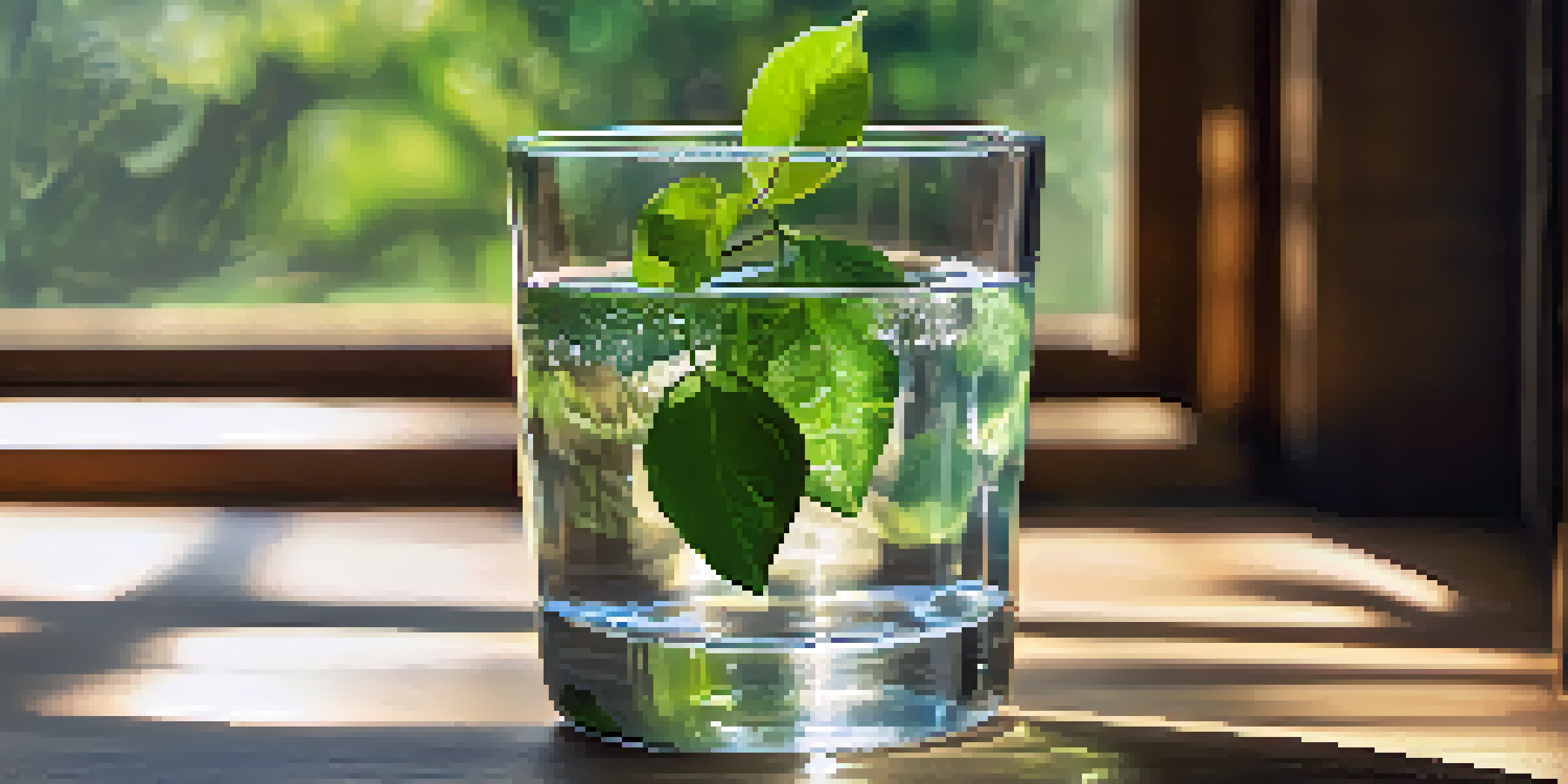Water Purification: Techniques for Safe Drinking Water

Understanding the Importance of Water Purification
Water is essential for life, but not all sources are safe for consumption. Contaminants can enter our drinking water from various sources, including industrial runoff, sewage, and even natural sources like rivers and lakes. This makes water purification crucial to ensure that what we drink is free from harmful substances.
Water is the driving force of all nature.
Purification helps remove bacteria, viruses, chemicals, and heavy metals, making water safe for drinking and cooking. By understanding the types of contaminants present, we can make informed choices about the purification methods suitable for our needs. Ultimately, safe drinking water contributes to better health and well-being for all.
In an age where health is a priority, investing time and resources into water purification is essential. Not only does it protect individual health, but it also promotes a cleaner environment. Let's delve deeper into various purification techniques that can help us achieve safe drinking water.
Boiling: An Age-Old Technique for Purification
Boiling is one of the simplest and most effective methods for purifying water. By heating water to a rolling boil for at least one minute, harmful microorganisms are killed, making it safe to drink. This method is particularly useful in emergency situations or when traveling to areas with questionable water sources.

However, while boiling effectively removes biological contaminants, it doesn't eliminate chemical pollutants or heavy metals. Therefore, it's best to consider boiling as part of a multi-step purification process, especially for water suspected to be chemically contaminated. It's also energy-intensive, which can be a drawback in resource-limited settings.
Water Purification is Essential
Ensuring safe drinking water through purification methods protects health and contributes to overall well-being.
Despite its limitations, boiling remains a go-to method for many households, especially in rural areas. It’s easy to do and requires minimal equipment, making it accessible to everyone. So, if you're in a pinch, remember that boiling can be a lifesaver!
Filtration: A Versatile Purification Approach
Filtration is a popular water purification technique that involves passing water through a filter to remove impurities. Filters can vary in complexity from simple carbon filters to advanced reverse osmosis systems. This versatility allows users to select a filtration method that best suits their specific needs.
The health of our water is the foundation of the health of our communities.
One of the key benefits of filtration is its ability to reduce chemical contaminants, including chlorine, lead, and other harmful substances. Additionally, many filter systems come equipped with indicators that signal when it's time to replace the filter, ensuring continued effectiveness. This proactive approach helps maintain water quality over time.
However, it's essential to regularly maintain and replace filters to ensure optimal performance. Neglecting this can lead to reduced effectiveness and possible contamination. With the right care, filtration systems can provide a reliable source of safe drinking water for your family.
Chemical Purification: Using Chemicals for Safety
Chemical purification involves using substances like chlorine or iodine to disinfect water. These chemicals target and kill pathogens, making the water safe to drink. It's a common method used in municipal water treatment facilities and is particularly effective for emergency situations.
While chemical purification is effective, it can leave an aftertaste that some people find unpalatable. Additionally, it's important to use the correct dosage, as too much can lead to health issues. Therefore, it's advisable to follow guidelines carefully when using chemical treatments.
Variety of Purification Techniques
Different methods like boiling, filtration, and UV purification cater to various contaminants and needs.
This method is especially useful in situations where biological contaminants are a concern. For instance, if you're camping or traveling in remote areas, carrying chlorine tablets can be a practical solution to ensure safe drinking water. Just remember, when it comes to chemical purification, a little goes a long way!
UV Purification: Harnessing Light for Clean Water
Ultraviolet (UV) purification is a modern technique that uses UV light to kill bacteria, viruses, and other pathogens in water. By exposing water to UV light for a specific duration, harmful microorganisms are rendered harmless, ensuring safe drinking water. This method is chemical-free and leaves no aftertaste.
One of the standout features of UV purification is its speed and efficiency. It can purify large volumes of water in a short amount of time, making it suitable for both home use and larger-scale operations. However, UV purification requires clear water to be effective, as turbidity can shield pathogens from UV light.
While UV purifiers can be a bit pricier than traditional methods, their effectiveness and eco-friendliness make them worth considering. Plus, they often come with easy-to-use features, making water purification a breeze. If you're looking for a high-tech solution, UV purification might be your best bet!
Distillation: A Comprehensive Purification Method
Distillation is a thorough water purification technique that involves boiling water and then condensing the steam back into liquid form. This process effectively removes a wide range of contaminants, including salts, heavy metals, and pathogens. It's particularly useful in areas where water is heavily polluted or contains dissolved solids.
While distillation is highly effective, it can be time-consuming and energy-intensive, making it less practical for everyday use. Additionally, some volatile organic compounds may not be removed through this process, requiring supplemental purification methods. Therefore, it's best used in conjunction with other techniques to ensure comprehensive water quality.
Future Innovations in Purification
Emerging technologies promise to enhance water purification efficiency and accessibility for all.
Despite its challenges, distillation offers peace of mind, knowing that you're consuming thoroughly purified water. For those looking for a robust solution, investing in a distillation unit might be a smart move, providing you with safe drinking water whenever you need it.
Choosing the Right Method for Your Needs
With a variety of water purification techniques available, choosing the right one for your needs can be daunting. Factors like the source of your water, the types of contaminants present, and your budget all play a role in determining the best method. It's essential to assess these factors carefully to make an informed decision.
For instance, if you're dealing with biological contaminants, boiling or UV purification may be your best options. If you're concerned about chemical pollutants, filtration or distillation could be more effective. Understanding your water quality and potential risks will help guide you toward the most suitable purification technique.

Ultimately, investing in the right water purification method can significantly impact your health and well-being. Whether it's for your home, during travel, or in emergency situations, having access to safe drinking water is invaluable. By taking the time to choose wisely, you can ensure that you and your family stay healthy and hydrated.
The Future of Water Purification Technologies
As the demand for clean water continues to grow, so does innovation in water purification technologies. From advanced filtration systems to smart UV purifiers with app connectivity, the future looks bright for those seeking safe drinking water. These technologies not only improve efficiency but also enhance our ability to monitor water quality in real-time.
Emerging methods such as nanotechnology and solar-powered purification systems are also on the horizon. These advancements promise to make water purification more accessible and sustainable, particularly in underserved regions. By harnessing new technologies, we can work toward a world where everyone has reliable access to clean drinking water.
It's an exciting time for water purification, and staying informed about these developments can help you make better choices for your health. As we look to the future, embracing innovation will play a crucial role in ensuring that safe drinking water is available for generations to come.